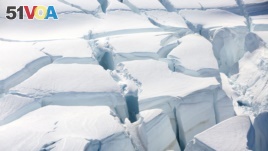07 April 2020
Today we know Antarctica as an extreme environment containing ice and snow. But new research provides evidence that the area was very different in the past.
The evidence was found inside a piece of Earth sediment collected by researchers from under the seafloor off the coast of Antarctica. In the sediment, they found forest soil estimated to be about 90 million years old. This would have been in the Cretaceous Period, when dinosaurs were the main land animals.

FILE - A glacier is shown in a photo taken in Half Moon Bay, Antarctica, Feb. 18, 2018.
The sediment was removed by scientists on the research icebreaker RV Polarstern in the Amundsen Sea near the Pine Island Glacier.
Johann Klages is a geologist with the Alfred Wegener Institute's Helmholtz Center for Polar and Marine Research in Germany. He was the lead writer of a study on the findings, published in the journal Nature.
He said the sediment was collected from a depth of about 30 meters below the ocean floor. Klages said an examination showed that the material formed on land, not in the ocean.
The researchers estimate that the area – about 900 kilometers from the South Pole – had average yearly temperatures of about 12 to 13 degrees Celsius. During the warmest summer months, average temperatures likely reached between 20 to 25 degrees Celsius.
The average yearly temperature in that area is about 40 degrees below zero Celsius.
The examination process included the use of X-ray imaging technology. Those results showed "a dense network of roots that spread through the entire soil layer," the Helmholtz Center said in a statement. The condition of the soil was in such good condition that the researchers could see individual cell structures.
The dark brownish-gray soil included fine dirt particles and hard clay, as well as substances linked to at least 65 different kinds of plants, the study found.
"If you would go to a forest near you and drill a hole, it would probably look pretty similar," Klages told the Reuters news agency.
He added that the plants included trees, ferns and flowering plants. While no animal remains were found, Klages said there were likely dinosaurs, flying reptiles and many insects in the environment.
The research represents new evidence of the major climate changes Earth has experienced in the past - and is currently undergoing today. The soil dates back to the planet's warmest period of the past 140 million years, with sea levels about 170 meters higher than today.
The researchers said that the rainforest environment in Antarctica was especially surprising because each year, the area experiences a four-month polar night when there is no sunlight to fuel plant life. Klages said no ice sheets were present during the time, but seasonal snowfall was likely.
I'm Bryan Lynn.
Reuters reported on this story. Bryan Lynn adapted the report for VOA Learning English, with additional information from the Helmholtz Center for Polar and Marine Research. Caty Weaver was the editor.
We want to hear from you. Write to us in the Comments section, and visit 51VOA.COM.
________________________________________________________________
Words in This Story
sediment – n. a solid substance that forms a later at the bottom of a liquid
geologist – n. a scientist who studies the history of the earth and its life, especially as recorded in rocks
preserve – v. keep something the same or keep it from being damaged or destroyed
network – n. an interconnected or interrelated chain, group, or system
clay – n. a heavy, sticky material from the earth that is made into different shapes and that becomes hard when it is baked or dried
drill – v. make holes in hard materials with a machine